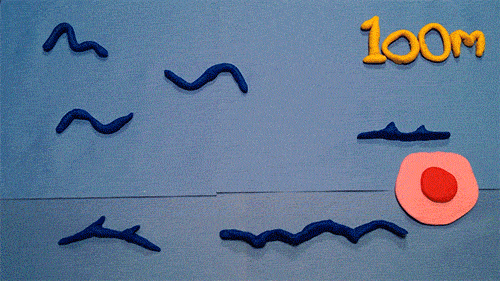You Just Scrolled Over A High-res Segment Of The Andromeda Galaxy. How Does NASA Get Its Photos To Look




You just scrolled over a high-res segment of the Andromeda galaxy. How does NASA get its photos to look so spectacular? The same way as everyone else.
More Posts from Curiositytherover and Others
We’re With You When You Fly

Did you know that “We’re With You When You Fly”? Thanks to our advancements in aeronautics, today’s aviation industry is better equipped than ever to safely and efficiently transport millions of passengers and billions of dollars worth of freight to their destinations. In fact, every U.S. Aircraft flying today and every U.S. air traffic control tower uses NASA-developed technology in some way. Here are some of our objectives in aeronautics:
Making Flight Greener

From reducing fuel emissions to making more efficient flight routes, we’re working to make flight greener. We are dedicated to improving the design of airplanes so they are more Earth friendly by using less fuel, generating less pollution and reducing noise levels far below where they are today.
Getting you safely home faster

We work with the Federal Aviation Administration to provide air traffic controllers with new tools for safely managing the expected growth in air traffic across the nation. For example, testing continues on a tool that controllers and pilots can use to find a more efficient way around bad weather, saving thousands of pounds of fuel and an average of 27 minutes flying time per tested flight. These and other NASA-developed tools help get you home faster and support a safe, efficient airspace.
Seeing Aviation’s Future

Here at NASA, we’re committed to transforming aviation through cutting edge research and development. From potential airplanes that could be the first to fly on Mars, to testing a concept of a battery-powered plane, we’re always thinking of what the future of aviation will look like.
Make sure to follow us on Tumblr for your regular dose of space: http://nasa.tumblr.com

The remote-controlled robots that were sent into the site of the 2011 meltdown at the Fukushima Daiichi nuclear power plant in Japan have reportedly ‘died’, thanks to incredibly high amounts of leaked radiation destroying their wiring.
The robots - which take years to manufacture - were designed to swim through the underwater tunnels of the now-defunct cooling pools, and remove hundreds of extremely dangerous blobs of melted fuel rods. But it looks like that’s not going to happen any time soon.
In 2011, one of the most severe earthquakes in recorded history triggered a 10-metre-high tsunami that crashed into Japan’s Fukushima nuclear power plant, leading to several meltdowns that killed nearly 19,000 people and destroyed the homes and jobs of 160,000.

NASA Astronomy Picture of the Day 2016 September 4
Io over Jupiter from Voyager 1
Back in 1979, NASA’s Voyager 1 spacecraft flew past Jupiter and its moons. The images in this mosaic, featuring the moon Io against a background of gas giant Jupiter’s diffuse swirling cloud bands, were recorded by Voyager’s camera from a distance of about 8.3 million kilometers. The Io image from this mosaic may be the first to show curious round features on Io’s surface with dark centers and bright rims more than 60 kilometers across. Now known to be volcanic in origin, these features were then thought likely to be impact craters, commonly seen on rocky bodies throughout the Solar System. But as Voyager continued to approach Io, close-up pictures revealed a bizarre world devoid of impact craters, frequently resurfaced by volcanic activity. Earlier this year a new robotic spacecraft, NASA’s Juno, began to orbit Jupiter and last week made a pass within 5,000 kilometers of Jupiter’s clouds. During the next two years, it is hoped that Juno will discover new things about Jupiter, for example what’s in Jupiter’s core.










From Pluto to food grown in space, NASA is having a great year. But even more mysterious than those discoveries, a spacecraft found two eerily bright lights on a distant dwarf planet.

One of the physicists who helped find the Higgs boson, Elina Berglund, has spent the past three years working on something completely different - a fertility app that tells women when they’re fertile or not.
It’s not the first fertility app out there, but Berglund’s app works so well that it’s been shown to help women avoid pregnancy with 99.5 percent reliability - an efficacy that puts it right up there with the pill and condoms.
Best of all, the app doesn’t have any side effects, and just requires women to input their temperature daily to map their fertility throughout the month.
Back in 2012, Berglund was working at CERN on the Large Hadron Collider experiment to find the famous Higgs boson. But after the discovery of the particle, she felt it was time to work on something completely different.
“I wanted to give my body a break from the pill,” she told Daniela Walker from Wired, “but I couldn’t find any good forms of natural birth control, so I wrote an algorithm for myself.”
The resulting app is called Natural Cycles, and so far, it’s had pretty promising results.
Continue Reading.



A major breakthrough could let both same-sex partners be biological parents to their kids
Could two same-sex partners ever be biologically related to one baby? Maybe. With a relatively new process called in vitro gametogenesis, or IVG, scientists could combine genetic material from both parents. While we may have to wait a bit for it — here’s how it works.

Report: A host of common chemicals endanger child brain development
In a new report, dozens of scientists, health practitioners and children’s health advocates are calling for renewed attention to the growing evidence that many common and widely available chemicals endanger neurodevelopment in fetuses and children of all ages.
The chemicals that are of most concern include lead and mercury; organophosphate pesticides used in agriculture and home gardens; phthalates, which are used in pharmaceuticals, plastics and personal care products; flame retardants known as polybrominated diphenyl ethers; and air pollutants produced by the combustion of wood and fossil fuels, said University of Illinois comparative biosciences professor Susan Schantz, one of dozens of individual signatories to the consensus statement.
Polychlorinated biphenyls, once used as coolants and lubricants in transformers and other electrical equipment, also are of concern. PCBs were banned in the U.S. in 1977, but can persist in the environment for decades, she said.
The new report, “Project TENDR: Targeting Environmental NeuroDevelopment Risks,” appears in the journal Environmental Health Perspectives. The group also has a website with information about each of the chemicals of concern.
“These chemicals are pervasive, not only in air and water, but in everyday consumer products that we use on our bodies and in our homes,” Schantz said. “Reducing exposures to toxic chemicals can be done, and is urgently needed to protect today’s and tomorrow’s children.”
Schantz is a faculty member in the College of Veterinary Medicine and in the Beckman Institute for Advanced Science and Technology at the U. of I.
“The human brain develops over a very long period of time, starting in gestation and continuing during childhood and even into early adulthood,” Schantz said. “But the biggest amount of growth occurs during prenatal development. The neurons are forming and migrating and maturing and differentiating. And if you disrupt this process, you’re likely to have permanent effects.”
Some of the chemicals of concern, such as phthalates and PBDEs, are known to interfere with normal hormone activity. For example, most pregnant women in the U.S. will test positive for exposure to phthalates and PBDEs, both of which disrupt thyroid hormone function.
“Thyroid hormone is involved in almost every aspect of brain development, from formation of the neurons to cell division, to the proper migration of cells and myelination of the axons after the cells are differentiated,” said Schantz. “It regulates many of the genes involved in nervous system development.”
Schantz and her colleagues at Illinois are studying infants and their mothers to determine whether prenatal exposure to phthalates and other endocrine disruptors leads to changes in the brain or behavior. This research, along with parallel studies in older children and animals, is a primary focus of the Children’s Environmental Health Research Center at Illinois, which Schantz directs.
Phthalates also interfere with steroid hormone activity. Studies link exposure to certain phthalates with attention deficits, lower IQ and conduct disorders in children.
“Phthalates are everywhere; they’re in all kinds of different products. We’re exposed to them every day,” Schantz said.
The report criticizes current regulatory lapses that allow chemicals to be introduced into people’s lives with little or no review of their effects on fetal and child health.
“For most chemicals, we have no idea what they’re doing to children’s neurodevelopment,” Schantz said. “They just haven’t been studied.
“And if it looks like something is a risk, we feel policymakers should be willing to make a decision that this or that chemical could be a bad actor and we need to stop its production or limit its use,” she said. “We shouldn’t have to wait 10 or 15 years – allowing countless children to be exposed to it in the meantime – until we’re positive it’s a bad actor.”
4 Fun Facts Animated by Teachers
Last week, the TED-Ed Animation Team facilitated animation workshops with TED-Ed Innovative Educators. We introduced them to basic stop-motion tricks and techniques in hopes that they would begin to incorporate animation into their classroom projects - and based on the results, we think they are up to the challenge!
Earlier this fall, we sourced some fun facts from the educators themselves, and then tasked them with visualizing that very information. We used tablets with #istopmotion to shoot the animation, and basic household objects and school supplies as props and materials. We dare say that you, too, can do this from home!

1. When an object’s mass doubles, its kinetic energy also doubles, but when an object’s SPEED doubles, its kinetic energy quadruples.

2. If a male sperm was the size of a human being, it would swim the 100 metre freestyle in half of the world record time.

3. Approximately one word is added to the English language every two hours.

4. If you condensed the Earth’s history into 24 hours, humans wouldn’t exist until 11:58pm.

A fascinating new simulation finds that self-driving cars will terraform cities:90% of cars will be eliminated, acres of land will open up, and commute times will drop 10%. A team of transportation scientists at the Organization for Cooperation and Development took data on actual trips in Lisbon, Portugal and looked at how a fleet of self-driving, shared “taxibots” would change city landscape [PDF].
We need to move to large scale implementation as soon as the technology is good enough

We normally post our tech news roundups on Fridays, but due to turkey, football, and lots of napping, we’re publishing it today instead. Enjoy!
1. The right drones for everyone this holiday season Love is in the air, and here’s a list of UAVs you can use to catch it. There’s never been a better reason to sit around while your relatives drone on and on. Really. With gifts like these the holidays will fly right by. via: Quartz
2. New tech can wirelessly charge your electronics with a standard Wi-Fi router There’s a good reason your Wi-Fi router is always shooting dirty looks at your laptop’s power cord. But rather than stoop to their level, routers everywhere are taking up the slack. Try to be sympathetic when your power cord finally winds up jobless. It’s bound to come as a shock. via: BGR 3. The Pickle Index is a Delightfully Weird, App-Driven Novel Like No Other Immersive multimedia experiences are becoming more and more advanced every day, but there are plenty of people who still use monomedia to get their virtual realities. With The Pickle Index, techies and bookworms will finally have something to talk about if they’re both forced to interact with other humans. via: WIRED
4. Circuit Board Tattoos That Actually Work Will Make Your Cyborg Fantasies Come True Do yourself a favor and only get tattoos in languages that you understand. Otherwise you might end up with a bunch of spurious output, and it’s going to take forever to find that missing comma. via: Gizmodo
-
 sparkleoflilac liked this · 1 year ago
sparkleoflilac liked this · 1 year ago -
 knowledgeeee liked this · 2 years ago
knowledgeeee liked this · 2 years ago -
 inkytides reblogged this · 2 years ago
inkytides reblogged this · 2 years ago -
 dethcloud7 reblogged this · 2 years ago
dethcloud7 reblogged this · 2 years ago -
 deathgodchild reblogged this · 2 years ago
deathgodchild reblogged this · 2 years ago -
 where-the-wild-things-sleep liked this · 2 years ago
where-the-wild-things-sleep liked this · 2 years ago -
 eclectichellmouth reblogged this · 2 years ago
eclectichellmouth reblogged this · 2 years ago -
 emiliosandozsequence reblogged this · 3 years ago
emiliosandozsequence reblogged this · 3 years ago -
 sammnotviole liked this · 3 years ago
sammnotviole liked this · 3 years ago -
 mermiku liked this · 4 years ago
mermiku liked this · 4 years ago -
 diamondhenry liked this · 4 years ago
diamondhenry liked this · 4 years ago -
 beastmode-holefiller liked this · 4 years ago
beastmode-holefiller liked this · 4 years ago -
 beenthroughalot liked this · 5 years ago
beenthroughalot liked this · 5 years ago -
 queencfthestars reblogged this · 5 years ago
queencfthestars reblogged this · 5 years ago -
 mars-amon liked this · 5 years ago
mars-amon liked this · 5 years ago -
 parallele reblogged this · 5 years ago
parallele reblogged this · 5 years ago -
 madprohetess liked this · 5 years ago
madprohetess liked this · 5 years ago -
 audhdfrey liked this · 6 years ago
audhdfrey liked this · 6 years ago -
 arabellastark liked this · 6 years ago
arabellastark liked this · 6 years ago -
 toberaikage liked this · 6 years ago
toberaikage liked this · 6 years ago -
 ihavenotdiedtoday liked this · 6 years ago
ihavenotdiedtoday liked this · 6 years ago -
 seaofconstellations-blog reblogged this · 6 years ago
seaofconstellations-blog reblogged this · 6 years ago -
 wachsurfer2018 liked this · 6 years ago
wachsurfer2018 liked this · 6 years ago -
 yxcvbnm666 liked this · 6 years ago
yxcvbnm666 liked this · 6 years ago -
 fiverfrank liked this · 6 years ago
fiverfrank liked this · 6 years ago -
 kkyy-6 liked this · 6 years ago
kkyy-6 liked this · 6 years ago -
 gakittajp liked this · 6 years ago
gakittajp liked this · 6 years ago -
 possum-warfare-committee liked this · 6 years ago
possum-warfare-committee liked this · 6 years ago -
 king-of-the-rain-and-wolves reblogged this · 6 years ago
king-of-the-rain-and-wolves reblogged this · 6 years ago -
 king-of-the-rain-and-wolves liked this · 6 years ago
king-of-the-rain-and-wolves liked this · 6 years ago -
 greypandainspo reblogged this · 6 years ago
greypandainspo reblogged this · 6 years ago